Winter (December 2022, January & February 2023)
Cold start, mild and dry overall
The first half of December 2022 saw very cold arctic air masses dominating, with high pressure to the north and the Jetstream displaced well to the south of Ireland, leading to drier than average conditions and a negative North Atlantic Oscillation. The second half of the December was less cold with Atlantic low pressure systems dominating bringing wetter than average conditions as the North Atlantic Oscillation became positive and stayed positive throughout the rest of the winter. The first half of January 2023 was mild, wet and often windy with Atlantic low pressure systems to the west and northwest steering numerous weather fronts across the country. The second half of the month was much drier, especially in the East. A cold blast from the north brought snow in places at first, before milder air moved in from the west as high pressure built to the south. High pressure continued to dominate through most of February, bringing mostly mild and very dry conditions countrywide. There was no named storms that affected Ireland through winter 2022/23. A sudden stratospheric warming began on Thursday 16th February, but occurred too late to influence the winter weather.
Rainfall: Below average nearly everywhere, driest in the East
Only one seasonal rainfall total was above their 1981-2010 Long-Term Average (LTA). Percentage of seasonal rainfall values ranged from 67% (seasonal rainfall total of 148.4 mm) at Oak Park, Co Carlow to 105% (seasonal rainfall total of 388.4 mm) at Belmullet, Co Mayo. Seasonal rainfall totals for the season ranged from 131.4 mm (71% of its LTA) at Dublin Airport to 429.4 mm (91% of its LTA) at Newport, Co Mayo. The highest daily rainfall total was 41.3 mm at Belmullet, Co Mayo on Christmas Day, Sunday 25th December. The number of rain days ranged from 43 days at Oak Park, Co Carlow to 75 days at Belmullet, Co Mayo. The number of wet days ranged from 29 days at both Phoenix Park, Co Dublin and Oak Park, Co Carlow to 59 days at Belmullet, Co Mayo. The number of very wet days ranged from 3 days at a few stations to 17 days at Valentia Observatory, Co Kerry. Five stations had dry spells between Sunday 27th November and Sunday 18th December lasting between 15 and 22 days. These were Ballyhaise, Co Cavan (22 days), Shannon Airport, Co Clare (18 days), Moore Park, Co Cork (16 days), Claremorris and Knock Airport, Co Mayo (15 days). Nine stations had dry spells between Monday 16th January and Tuesday 14th February lasting between 16 and 30 days. These were Dublin Airport, Co Dublin, Dunsany, Co Meath (30 days), Johnstown Castle, Co Wexford (22 days), Roches Point, Co Cork (21 days), Casement Aerodrome, Co Dublin (20 days), Phoenix Park, Co Dublin (19 days), Moore Park, Co Cork, Oak Park, Co Carlow and Shannon Airport, Co Clare (16 days). There was one absolute drought at Johnstown Castle, Co Wexford between Wednesday 25th January and Thursday 9th February lasting 16 days. There were two partial droughts at Dublin Airport (31 days) and Phoenix Park, Co Dublin (30 days) between Saturday 14th January and Tuesday 14th February.
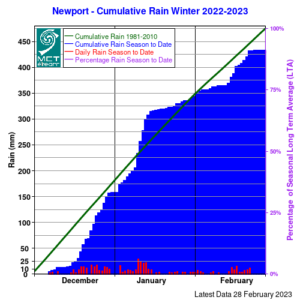
Newport, Co Mayo rainfall Graph for Winter 2022/23
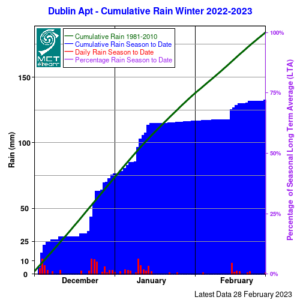
Dublin Airport rainfall Graph for Winter 2022/23
Temperature: Above average nearly everywhere, highest in the Southwest
Only one station had below normal mean air temperatures for the season. Deviations from mean air temperature ranged from -0.3 °C (5.2 °C mean temperature) at Markree, Co Sligo to 0.9 °C (6.1 °C mean temperature) at Phoenix Park, Co Dublin. Mean temperatures for the season ranged from 4.9 °C (0.7 °C above its LTA) at Knock Airport, Co Mayo to 7.8 °C (0.1 °C above its LTA) at Sherkin Island, Co Cork. The season’s highest temperature was reported at Phoenix Park, Co Dublin on Tuesday 14th February with a temperature of 15.9 °C. The season’s lowest air and grass minimum was recorded at Mount Dillon, Co Roscommon with the lowest air temperature reported on Friday 16th December with -8.8 °C (the lowest minimum in Ireland since December 2010), while the lowest grass minimum was -13.0 °C reported on Wednesday 14th December. All stations reported air and ground frost during the season. The number of days with ground frost ranged from 16 days at Sherkin Island, Co Cork to 57 days at Markree, Co Sligo. The number of days with air frost ranged from 6 days at both Roche’s Point, Co Cork and Malin Head, Co Donegal to 27 days at Mount Dillon, Co Roscommon.
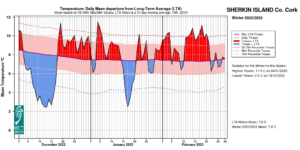
Sherkin Island, Co Cork temperature: Daily mean departure from LTA for winter 2022/23
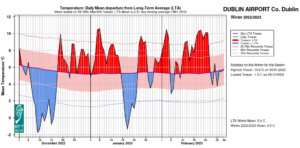
Dublin Airport temperature: Daily mean departure from LTA for winter 2022/23
Sunshine: Sunniest in the South and East
All available sunshine totals were above their Long-Term Average (LTA) for the season. Percentage of seasonal sunshine values ranged from 112% (seasonal sunshine total of 181.0 hours) at Shannon Airport, Co Clare to 118% (seasonal sunshine total of 204.2 hours) at Casement Aerodrome, Co Dublin. Seasonal sunshine totals ranged from 129.2 hours (No LTA comparison*) at Malin Head, Co Donegal to 236.0 hours (No LTA comparison*) at Dublin Airport, Co Dublin. The highest number of daily sunshine hours recorded this season was 9.5 hours at Belmullet, Co Mayo on Monday 27th February. The number of dull days ranged from 22 days at Johnstown Castle, Co Wexford to 41 days at Valentia Observatory, Co Kerry.
Wind: Storm force winds reported, no named storms
Seasonal mean wind speeds ranged from 5.7 knots (10.6 km/h) at Moore Park, Co Cork to 16.4 knots (30.4 km/h) at Malin Head, Co Donegal. Gales were reported on numerous days with up to strong gales reported on the 7th, 11th, 14th, 15th January and 21st December. Storm force winds were reported on Thursday 12th January. The number of days with gales ranged from zero days at a few stations to 17 days at Malin Head, Co Donegal. The number of days with up to strong gales ranged from zero days at most stations to 4 days at Mace Head, Co Galway. Both the season’s highest gust and 10-minute mean wind speed was reported at Mace Head, Co Galway on Thursday 12th January. The highest gust was 66 knots (122 km/h) while the season’s highest 10-minute mean wind speed was 48 knots (89 km/h).
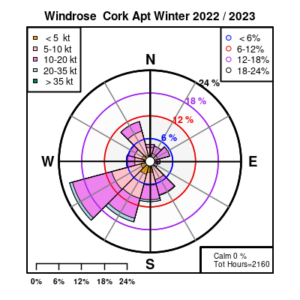
Wind rose for Cork Airport Max Daily Sustained (10-min mean) winter 2022/23 (provisional)
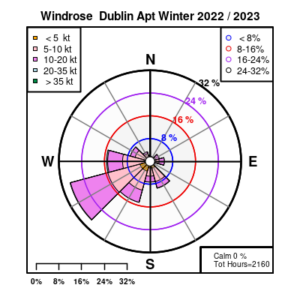
Wind rose for Dublin Airport Max Daily Sustained (10-min mean) winter 2022/23 (provisional)
The full report is available here (choose winter in the drop down menu for month)
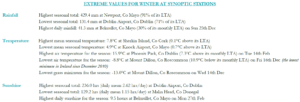
Winter 2022/23 extreme values at synoptic stations
February 2023
Very mild and very dry
High pressure dominated through most of February 2023, which brought very mild and very dry conditions countrywide. During the first week, high pressure, centred to the south of Ireland, brought mostly dry but relatively cloudy conditions in a south-westerly airflow. A few weak weather fronts crossed the country from the west but rainfall amounts stayed low, especially in the South and East. During the second week, high pressure developed to the southeast of Ireland, which brought a southerly airflow. It stayed mostly mild and dry apart from a weak weather front crossing the country on the 8th and some patchy rain or showers on the 14th. The third week brought less settled conditions as Atlantic weather fronts encroached from the west and brought some rain or showers on most days. High pressure stayed relatively close to the south, which kept rainfall amounts low, especially in the South and East again. The fourth week began with patchy rain or showers across the country on the 22nd, before high pressure built over Ireland from the west and dominated for the rest of the week, keeping it mostly dry. It was cooler as an easterly airflow developed, with a lot of sunshine in the West but cloudier in the East.
Rainfall: Below average everywhere, driest in the South an East
All monthly rainfall totals across the country were below their 1981-2010 Long-Term Average (LTA). Percentage of monthly rainfall values ranged from 10% (the month’s lowest monthly rainfall total of 7.4 mm) at Johnstown Castle, Co Wexford (its driest February since 1986) to 72 % (the month’s highest monthly rainfall total of 91.6 mm) at Newport, Co Mayo (its driest February since 2013). The highest daily rainfall total was 17.0 mm at Valentia Observatory, Co Kerry on Wednesday 15th. The number of rain days ranged from 8 days at Johnstown Castle, Co Wexford to 20 days at a few stations. The number of wet days ranged from 2 days at both Roche’s Point, Co Cork and Johnstown Castle, Co Wexford to 16 days at Newport, Co Mayo. The number of very wet days ranged from zero days at a few stations to 3 days at Newport, Co Mayo. Nine stations had dry spells between Monday 16th January and Tuesday 14th February lasting between 16 and 30 days. These were Dublin Airport, Co Dublin, Dunsany, Co Meath (30 days), Johnstown Castle, Co Wexford (22 days), Roches Point, Co Cork (21 days), Casement Aerodrome, Co Dublin (20 days), Phoenix Park, Co Dublin (19 days), Moore Park, Co Cork, Oak Park, Co Carlow and Shannon Airport, Co Clare (16 days). There was one absolute drought at Johnstown Castle, Co Wexford between Wednesday 25th January and Thursday 9th February lasting 16 days. There were two partial droughts at Dublin Airport (31 days) and Phoenix Park, Co Dublin (30 days) between Saturday 14th of January and Tuesday 14th February. Is was the driest February since 1965 at Dunsany, Co Meath and Phoenix Park, Co Dublin. It was the driest February since 1986 at Oak Park, Co Carlow, Johnstown Castle, Co Wexford and Cork Airport, Co Cork.
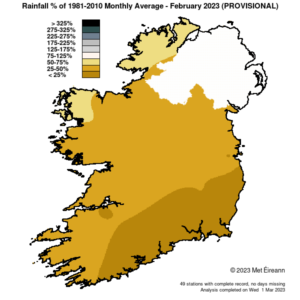
Rainfall % of 1981 – 2010 Monthly Average for February 2023 (Provisional)
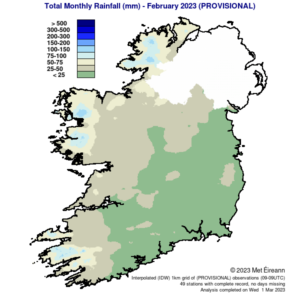
Total Monthly Rainfall (mm) for February 2023 (Provisional)
Temperature: Above average everywhere
All mean air temperatures across the country were above their LTA for the month. Deviations from mean air temperature ranged from 1.3 °C (8.8 °C mean temperature) at Sherkin Island, Co Cork to 2.4 °C at both Finner, Co Donegal and Phoenix Park, Co Dublin (7.8 °C and 7.6 °C mean temperature respectively). Mean temperatures for the month ranged from 6.5 °C (2.3 °C above its LTA) at Knock Airport, Co Mayo to 8.9 °C (1.6 °C above its LTA) at Valentia Observatory, Co Kerry. The month’s lowest temperatures were recorded on Sunday 5th with the lowest air minimum reported at Mullingar, Co Westmeath with a temperature of -4.3 °C and the lowest grass minimum reported at Oak Park, Co Carlow with -9.3 °C. The highest maximum was reported on Tuesday 14th at Phoenix Park, Co Dublin with a temperature of 15.9 °C. All stations reported ground frost during the month. The number of days with ground frost ranged from 1 day at Sherkin Island, Co Cork to 13 days at Mullingar, Co Westmeath. More than half of stations reported air frost. The number of days with air frost ranged from zero days at Mace Head, Co Galway to 6 days at both Markree, Co Sligo and Gurteen, Co Tipperary.
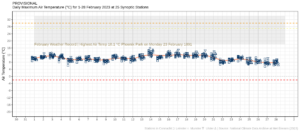
Highest screen air temperatures observed at each station each day during February 2023
Sunshine: Dull overall, sunniest in the Southeast
Nearly all available sunshine totals were below their LTA. Percentage of monthly sunshine values ranged from 90% (monthly sunshine total of 64.2 hours) at Casement Aerodrome, Co Dublin to 96% (monthly sunshine total of 62.7 hours) at Shannon Airport, Co Clare. Monthly sunshine totals ranged from 45.0 hours (No LTA comparison*) at Valentia Observatory, Co Kerry to 72.0 hours (No LTA comparison*) at Johnstown Castle, Co Wexford. The highest number of daily sunshine hours recorded this month was 9.5 hours at Belmullet, Co Mayo on Monday 27th. The number of dull days ranged from 5 days at Johnstown Castle, Co Wexford to 14 days at Valentia Observatory, Co Kerry.
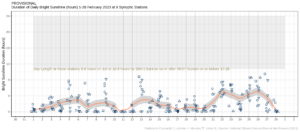
Hours of Bright Sunshine observed at each station for each day of the month, grouped by province for February 2023
Wind: Gales reported
Monthly mean wind speeds ranged from 5.7 knots (10.6 km/h) at Moore Park, Co Cork to 16.4 knots (30.4 km/h) at Malin Head, Co Donegal. Gales were reported on Wednesday 8th, Thursday 16th and Friday 17th. The number of days with gale force winds ranged from zero days at most stations to 3 days at Malin Head, Co Donegal. There were no strong gales or higher winds reported this month. Both the month’s highest gust and 10-minute mean wind speed was reported at Malin Head, Co Donegal. The highest gust was on Wednesday 8th and Friday 17th, with 52 knots (96 km/h) while the month’s highest 10-minute mean wind speed was 40 knots (74 km/h) on Friday 17th.
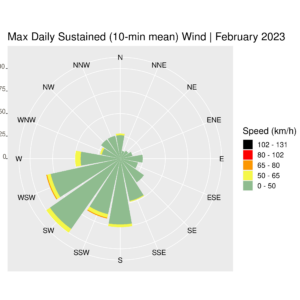
Wind rose for Ireland Max Daily Sustained (10-min mean) February 2023 (provisional)
The full report is available here
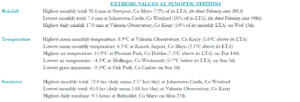
February 2023 extreme values at synoptic stations
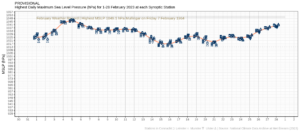
Highest daily mean sea level pressure (MSLP) observed at all available stations for February 2023
Recent Februarys in Ireland:
- 2016: Nearly all stations reported above their Long-Term Average (LTA) for rainfall and below for mean temperatures. Sunshine was below average in the South and East and above elsewhere. Storm Henry and Imogen brought storm force winds.
- 2017: Half of the rainfall totals were below. Mean air temperatures were above, sunshine was below, and Storm Doris brought the highest winds of the month.
- 2018: Nearly all stations were below average for monthly rainfall totals while all mean air temperatures were below average and sunshine totals were above.
- 2019: Nearly all rainfall totals were below average, while all mean air temperatures were above and sunshine was variable. Storm Erik brought storm-force winds to the West on the 8th.
- 2020: All rainfall totals were significantly above average, while nearly all mean temperatures were above and sunshine values varied. Storms, Ciara, Dennis and Jorge, brought prolonged periods of heavy rainfall and stormy weather.
- 2021: All rainfall totals were above average, nearly all mean air temperatures were above and sunshine totals varied.
- 2022: Nearly all rainfall totals were above average, while all mean air temperatures were above and sunshine varied. Storm Eunice brought violent storm force winds, storm Franklin brought storm force and storm Dudley brought gales.
A dry spell is a period of 15 or more consecutive days to which none are credited 1.0 mm or more of precipitation.
A absolute drought is a period of 15 or more consecutive days to which none are credited 0.2 mm or more of precipitation.
A partial drought is a period of at least 29 consecutive days, the mean daily rainfall of which does not exceed 0.2 mm. [daily rain/24 for mean daily rain then count of consecutive days not exceeding threshold.]
A rain day is a day with 0.2 mm or more of precipitation. Above table shows only those stations with 34 and more consecutive rain days.
A wet day is a day with 1.0 mm or more of precipitation. Above table shows only those stations with 20 and more consecutive wet days.
A very wet day is a day with 10.0 mm or more of precipitation. Above table shows only those stations with 3 and more consecutive very wet days.
For more information, contact Met Éireann at 01-8064200 or e-mail: enq@met.ie